Chapter 20.128
LANDSCAPING*
Sections:
20.128.020 Applicability and compliance.
20.128.040 Integration with LID stormwater management facilities.
20.128.050 Plant material and installation standards.
20.128.070 Landscape site design standards.
20.128.080 Development within required buffers.
20.128.090 Irrigation standards.
20.128.100 Maintenance of required buffers and landscaped areas.
20.128.110 Performance assurance/bonding.
20.128.120 Maintenance assurance/bonding.
* Prior legislation: Ords. 019-17 and 010-18.
20.128.010 Purpose.
It is the purpose of this chapter to:
(1) Promote well-planned and attractive landscaping that enhances the visual and aesthetic appearance of the city.
(2) Provide space definition and landscape continuity between the built environment and the natural environment.
(3) Provide appropriate barriers and relief from traffic, noise, heat, glare, and the spread of dust and debris.
(4) Reduce potential negative impacts between adjacent and neighboring uses.
(5) Reduce flooding and reduce the impact of development on the city’s storm drainage system.
(6) Promote tree retention and the protection of existing native vegetation.
(7) Provide for the long-term establishment and health of new landscape plantings.
(8) Aid in the conservation of energy and replenish the atmosphere with oxygen.
(9) Provide for a more pleasant and relaxing urban environment.
(10) Ensure the long term maintenance and attractiveness of landscape plantings.
(11) Maintain and enhance property values. (Ord. 011-19 § 5 (Exh. 2)).
20.128.020 Applicability and compliance.
(1) Applicability. The provisions of this chapter shall apply to all new nonresidential, single-family attached (three or more units), and multifamily (three or more units) development within the city. Also:
(a) The provisions of this chapter shall apply to building additions, remodels and site improvements per the Level I – III improvement thresholds set forth in POMC 20.127.020(3)(a) through (c).
(b) The maintenance provisions of this chapter apply to existing and previously approved landscape plans and required landscape areas.
(c) Temporary Deferral. A certificate of occupancy shall be contingent upon the screening and landscaping requirements of this chapter being met. This provision may be temporarily deferred by the director in cases where it is not reasonable for the developer to install certain species of plant material prior to occupancy due to the recommended planting season not occurring at an appropriate phase in construction. In such case, the time deadline for planting such materials shall be extended only to the nearest seasonal period suitable for planting such materials. Additionally, the director shall require that the applicant obtain a temporary deferral when water restrictions are in place preventing regular irrigation or watering of plant material. The director may authorize a temporary deferral through the issuance of a temporary certificate of occupancy or through the approval of a performance bond in accordance with this title.
(d) Review in Conjunction with Other Permits. Landscape plan review shall be performed in conjunction with other permit applications (i.e., land disturbing activity, stormwater drainage, building permit, etc.). Appeals of decisions related to the application of this chapter shall be connected to the underlying permit application to which the landscape code has been applied.
(e) The provisions of this chapter may also apply to subdivisions and short plats as specified in Chapter 20.100 POMC, but shall not apply to the construction of an individual detached house, duplex, or backyard cottage.
(2) Exceptions. The director may waive the provisions of this chapter for light industrial (LI) zoned properties which do not front Old Clifton Road or SR-160 depending on the type of use, number of anticipated employees and customers, and the site’s physical relationship and anticipated impacts to adjacent and neighboring zones, uses and development. (Ord. 011-19 § 5 (Exh. 2)).
20.128.030 Landscape plans.
(1) In order to implement the requirements of this section, landscape plans for the entire site are required as part of the following permit application submittals:
(a) Building permit applications.
(b) Preliminary plat applications.
(c) Short plat applications.
(d) Binding site plan applications.
(e) Conditional use permit applications (where new construction, or expansion of a building is proposed, or where landscaping is required to meet conditions for granting approval).
(f) Stormwater drainage permit applications.
(g) Land disturbing activity permit applications.
(2) In order to implement the requirements of this section, landscape plans for the entire site shall be required as part of a land disturbing activity permit application submittal if the scope of the permit application does not include restoration to predisturbance conditions or if the landscape plan approval is not issued under another permit approval as listed in subsection (1) of this section.
(3) Plans shall be developed by a Washington state licensed landscape architect, a Washington-certified professional horticulturalist (CPH), or a Washington certified professional landscape designer (APLD-WA).
(4) Landscape plans shall include:
(a) Boundaries and dimensions of the site.
(b) Location of existing and proposed easements, streets, curbs, utilities, sidewalks and any other hard surfaces.
(c) Location of buildings and structures, parking lots, driveways, loading areas, outdoor mechanical equipment, signs, refuse enclosures, overhead utilities, water meter location, swales, parking lot lighting, and any existing vegetation that is to remain on the site.
(d) The location and design of landscape areas to be preserved and planted, and plant list to include the location, number, height at maturity, and type of plant material by botanical and common name.
(e) Proposed irrigation system if a permanent or temporary system is proposed. All landscaped areas including adjacent right-of-way must be provided with an underground irrigation system.
(f) Specifications for soil amendments to provide suitable long term growing conditions.
(g) North arrow and scale.
(h) Planting detail section drawings.
(i) Name, address, and phone number of the person preparing the plan.
(j) Calculations demonstrating compliance with this chapter.
(k) Landscape planting, hardscape, and material precedents (imagery) depicting (approximately) the landscape plantings, hardscape, and materials to be used in the project.
(5) Applicants shall familiarize themselves with existing site conditions, and are encouraged to meet with staff to discuss appropriate design options and alternatives for accomplishing the screening and landscaping objectives of this chapter prior to preparing and submitting a landscape plan.
(6) Applicants are encouraged to integrate landscape plans and stormwater system designs consistent with the city’s adopted stormwater management manual. (Ord. 056-19 § 25; Ord. 011-19 § 5 (Exh. 2)).
20.128.040 Integration with LID stormwater management facilities.
The required landscape design requirements in this chapter may be integrated with low impact development (LID) stormwater management facilities and best management practices (BMPs) unless site and soil conditions make LID infeasible, subject to the approval of the director and public works department. LID facilities shall not compromise the purpose or intent of required landscaping and landscaping shall not result in the disruption of the LID facilities’ functions. LID facilities shall be designed and constructed in accordance and the LID Technical Guidance Manual for Puget Sound (current edition). (Ord. 011-19 § 5 (Exh. 2)).
20.128.050 Plant material and installation standards.
(1) Native Plant Species. New landscaping materials shall include species native to the region or hardy, waterwise, and noninvasive species appropriate in the climatic conditions of the region (decorative annuals are an exception). Generally acceptable plant materials must be those identified as hardy in Zone 8b as described in United States
Department of Agriculture’s Plant Hardiness Zone Map. The selection of plant species should include consideration of soil type and depth, the amount of maintenance required, spacing, exposure to sun and wind, the slope and contours of the site, compatibility with existing native vegetation preserved on the site, water conservation where needed, and the impact of landscaping on visibility of the site for purposes of public safety and surveillance.
(2) Tree Standards and Guidelines.
(a) Tree heights may be called for within this chapter or elsewhere within this title:
(i) Large Tree. Capable of growing 35 feet high or greater under normal growing conditions.
(ii) Medium Tree. Capable of growing over 15 feet high and less than 35 feet high under normal growing conditions.
(iii) Small Tree. Capable of growing up to 15 feet high under normal growing conditions.
(b) Unless otherwise noted herein, required trees shall meet the following standards at the time of planting:
(i) Required deciduous trees shall be fully branched, have a dominant leader branch, have a minimum caliper of one and one-half inches (as measured six inches above the root ball), and a minimum height of six feet at the time of planting as measured from the top of the leader branch to the top of the root ball.
(ii) Required evergreen trees shall be fully branched and a minimum of six feet in height, measured from the treetop to the ground, at the time of planting.
(iii) Required trees of any species within parking areas shall be a minimum caliper of one-and-one-half inches (as measured 24 inches above the root ball) and a minimum height of 10 feet at the time of planting.
(3) Shrub Standard. Shrubs, except for ornamental grasses, shall be a minimum of one-gallon size at the time of planting.
(4) Ground Cover Standards and Guidelines.
(a) Ground covers shall be planted and spaced to result in total coverage of the required landscape area within three years as follows, or as per recommendations by Washington State licensed landscape architect, Washington-certified professional horticulturalist (CPH), or other qualified individual. Ground cover plants other than turf forming grasses must be planted in triangular spacing at the following rates:
(i) Four-inch pots at 18 inches on center.
(ii) One gallon or greater sized containers at 24 inches on center.
(iii) Alternative plant spacing may be appropriate depending on the specific plants. When applicable, plant spacing information must be included with permit application submittals from published sources, such as the Sunset Western Garden Book, from Internet sources, or from cut sheets provided by a nursery. Such sources must be identified for verification purposes.
(b) Grass is acceptable as ground cover in landscaped areas, but generally not preferred for water conservation and maintenance purposes (lawn areas designed as play areas are an exception).
(c) Ground cover areas shall contain at least two inches of composted organic material at finished grade.
(5) Tree and Plant Diversity.
(a) If there are more than eight required trees, no more than 40 percent of them may be of one species.
(b) If there are more than 24 required trees, no more than 20 percent of them may be of one species.
(c) If there are more than 24 required shrubs, no more than 75 percent of them may be of one species.
(6) Soil Augmentation and Mulching.
(a) Existing soils shall be augmented with a two-inch layer of fully composted organic material tilled a minimum of six inches deep prior to initial planting.
(b) Landscape areas shall be covered with at least two inches of mulch to minimize evaporation. Mulch shall consist of organic materials such as bark chips and wood grindings or yard waste, sawdust, and/or manure that is fully composted. Washed rock may also be used as a mulch.
(7) Landscape Installation Standards.
(a) All required landscaping shall be in-ground, except when in raised planters. Plant materials shall be installed to current nursery industry standards.
(b) Plant materials shall be properly supported to ensure survival. Support devices such as guy wires or stakes shall not interfere with vehicular or pedestrian movement. Where support is necessary, stakes, guy wires or other measures shall be removed as soon as the plant can support itself.
(c) Existing trees and plant materials to be retained shall be protected during construction. Protection measures may include silt fencing, chain link fencing, or other sturdy fencing placed at the dripline of trees to be retained. Grading, topsoil storage, construction material storage, vehicles, and equipment shall not be allowed within the dripline of trees to be retained.
(d) Installation of landscaping materials must take into consideration access to utility vaults, pedestals, and other public and private utility facilities.
(e) Trees and major shrubs at mature size should avoid interference with windows, decks, pedestrian walkways or other travelled ways, or lighting. (Ord. 059-21 § 13; Ord. 011-19 § 5 (Exh. 2)).
20.128.060 Landscaping types.
(1) Type A Landscaping.
(a) Type A landscaping shall function as a full screen and visual barrier. This landscaping is typically found between residential and nonresidential areas and used to screen unwanted views.
(b) Type A landscaping shall minimally consist of:
(i) Trees. Predominately evergreen (more than 50 percent) at the following rates on landscape strips:
(A) One large tree per 300 square feet or 30 linear feet.
(B) One medium tree per 220 square feet or 22 linear feet.
(C) One small tree per 150 square feet or 15 linear feet.
At least 70 percent of the trees shall be large.
(ii) Shrubs. Predominately evergreen provided at a rate of one shrub per four linear feet of landscaped strip and spaced no more than eight feet on center.
(iii) Plant Diversity. Trees and shrubs must comply with POMC 20.128.050(5).
(iv) Ground Cover. Planted at a density to cover the landscape buffer per POMC 20.128.070 within three years.
(v) The selected plant materials and configuration will be able to screen 70 percent of the unwanted views within five years of planting and fully screen the unwanted view within six years. This requirement will account for the size of materials planted and their typical growth rate.
Figure 20.128.060(1)
Type A Landscaping Standards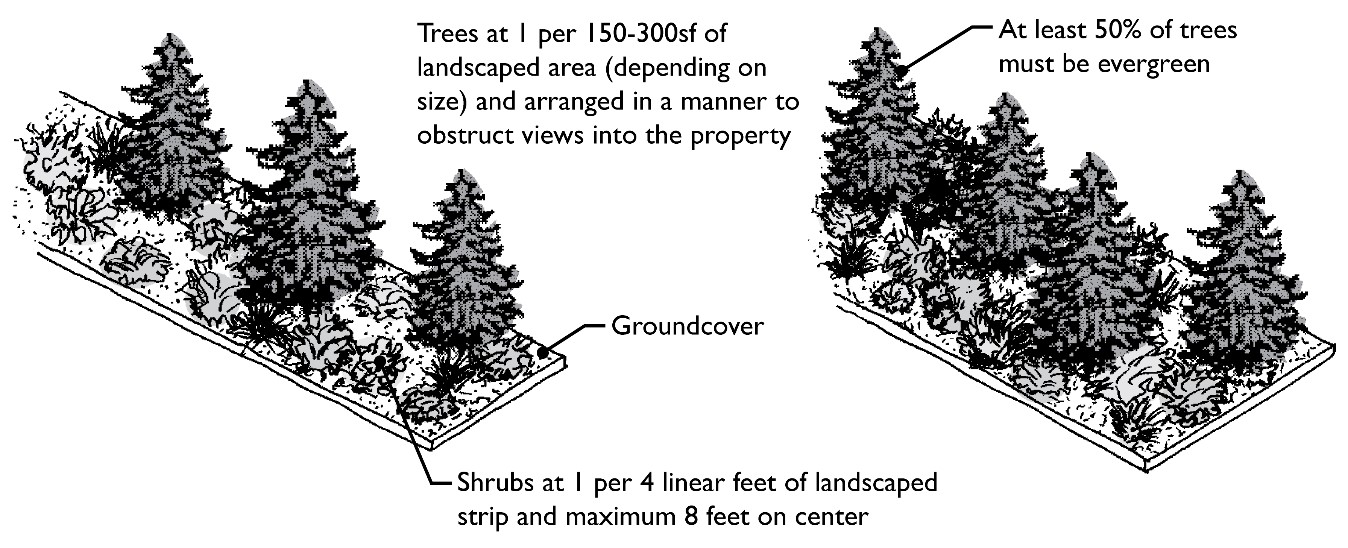
(2) Type B Landscaping.
(a) Type B landscaping is a “filtered screen” that functions as a visual separator. This landscaping is typically found between differing types of residential development and used to screen unwanted views from the pedestrian environment.
(b) Type B landscaping shall minimally consist of:
(i) Trees. At least 50 percent deciduous trees and at least 30 percent evergreen trees at the following rates on landscape strips:
(A) One large tree per 300 square feet or 30 linear feet.
(B) One medium tree per 220 square feet or 22 linear feet.
(C) One small tree per 150 square feet or 15 linear feet.
At least 70 percent of the trees shall be large.
(ii) Shrubs. Provided at the rate of one shrub per four linear feet of landscaped strip and spaced no more than eight feet on center.
(iii) Plant Diversity. Trees and shrubs must comply with POMC 20.128.050(5).
(iv) Ground Cover. Planted at a density to cover the landscape buffer per POMC 20.128.070 within three years.
(v) The selected plant materials and configuration will meet the purpose of the standards within five years of planting. This requirement will account for the size of materials and the growth rate.
Figure 20.128.060(2)
Type B Landscaping Standards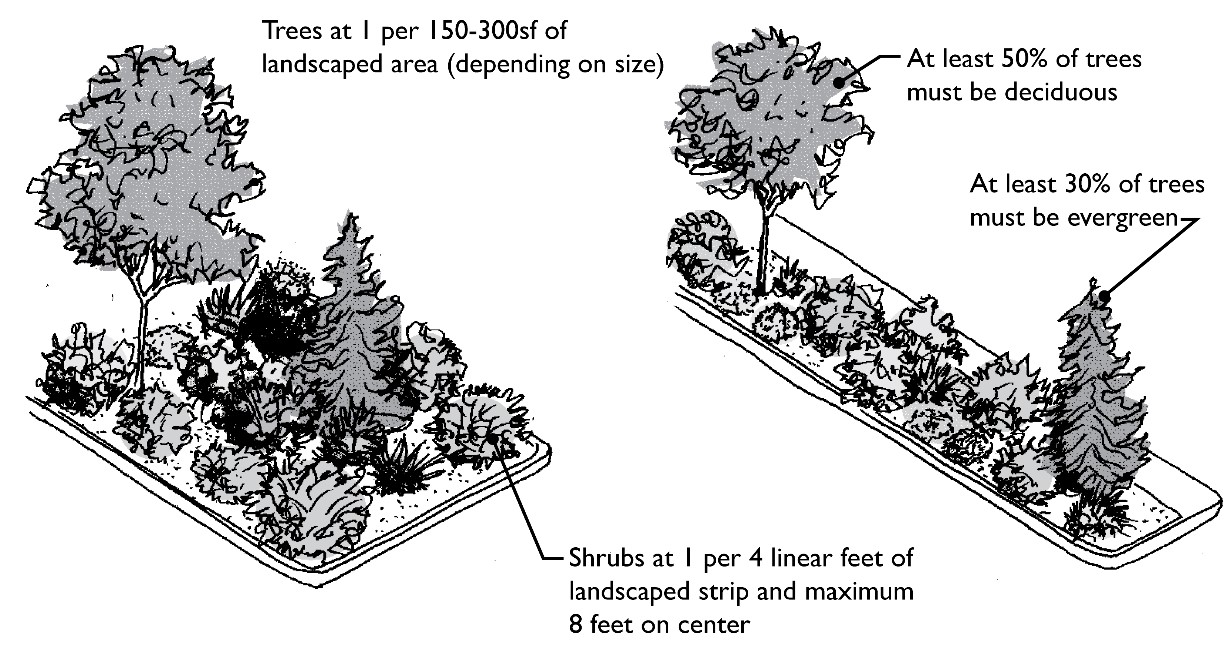
(3) Type C Landscaping.
(a) Type C landscaping is a “see-through screen” that functions as a partial visual separator to soften the appearance of parking areas and building elevations. This landscaping is typically found along street frontages or between multifamily developments.
(b) Type C landscaping shall minimally consist of:
(i) Trees. At least 70 percent deciduous trees at the following rates on landscape strips:
(A) One large tree per 300 square feet or 30 linear feet.
(B) One medium tree per 220 square feet or 22 linear feet.
(C) One small tree per 150 square feet or 15 linear feet.
At least 70 percent of the trees shall be large.
(ii) Shrubs. Provided at the rate of one shrub per four linear feet of landscaped strip and spaced no more than eight feet on center.
(iii) Ground Cover. Planted at a density to cover the landscape buffer per POMC 20.128.070 within three years.
(iv) Plant Diversity. Trees and shrubs must comply with POMC 20.128.050(5).
(v) Tree and shrub placement shall be designed to maximize pedestrian visibility (generally between three and eight feet above grade once trees have matured).
(vi) The selected plant materials and configuration will meet the purpose of the standards within five years of planting. This requirement will account for the size of materials and the growth rate.
(c) Where Type C landscaping is designed to also function as a rain garden, adjustments in the spacing of trees, shrubs, and ground cover will be allowed provided the rain garden meets the function requirements of subsection (6) of this section and the intended function of Type C landscaping as defined in subsection (3)(a) of this section.
Figure 20.128.060(3)
Type C Landscaping Standards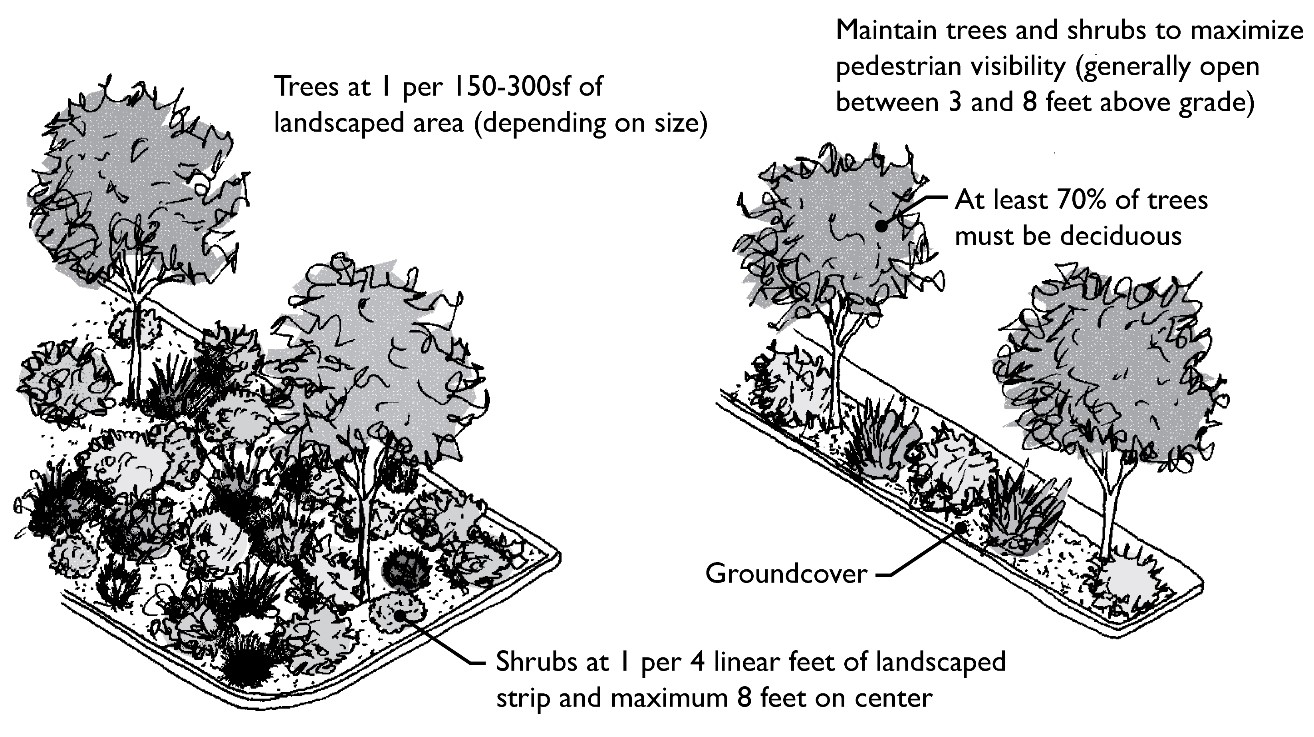
(4) Type D Landscaping.
(a) Type D landscaping refers to all other landscaped areas that do not qualify as Type A – C landscaping. While native and low maintenance trees and shrubs are encouraged in these areas, lawn areas may be used for recreational or design purposes. These areas may also include flower beds and perennial beds.
(b) Type D landscaping may include any combination of plant materials provided they comply with POMC 20.128.050.
(5) Low Hedge. A low hedge is intended to function as an attractive visual divider of space rather than a visual buffer between uses and properties. To qualify as a hedge landscaping type, the planting must be at least 30 inches wide and 30 inches tall. The hedge include plant materials that typically grow no taller than five feet at maturity or are maintained between 30 inches and 48 inches tall. Additional limits on hedges may be imposed by the public works director within required sight triangles at intersections. Shrubs or other hedge plant materials must be placed at a rate of one per four linear feet of landscaped strip or otherwise recommended for shrub species. Plant spacing information must be included with permit application submittals from published sources, such as the Sunset Western Garden Book, from Internet sources, or from cut sheets provided by the nursery.
Figure 20.128.060(5)
Low Hedge Examples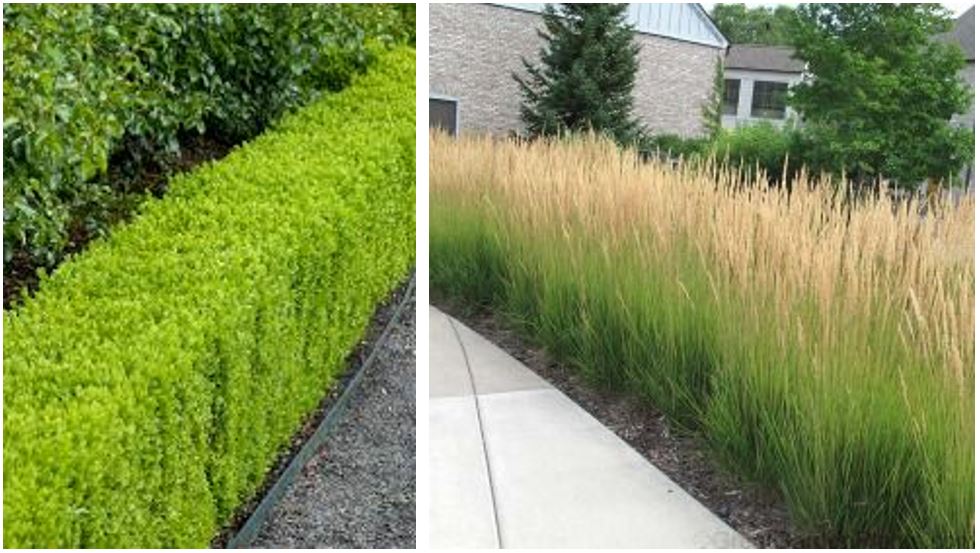
(6) Rain Garden. A rain garden is a landscaped depression that collects, absorbs, and filters stormwater runoff from rooftops, driveways, patios, and other hard surfaces. They can also function as an attractive visual divider of space. To qualify as a rain garden, the following elements must be included:
(a) Garden located and designed to capture impervious area runoff.
(b) Six to 12 inches ponding depth.
(c) Twelve to 24 inches rain garden soil depth with two to three inches surface mulch layer.
(d) Gradual side slopes (maximum 2:1).
(e) Overflow design elements with measures to protect erosion.
(f) Generous plantings (capable of reaching 100 percent ground cover) of a variety of small trees, shrubs, ground covers, and grasses. Select plants suitable for the three planting zones within the garden and around the perimeter.
Figure 20.128.060(6)
Rain Garden Examples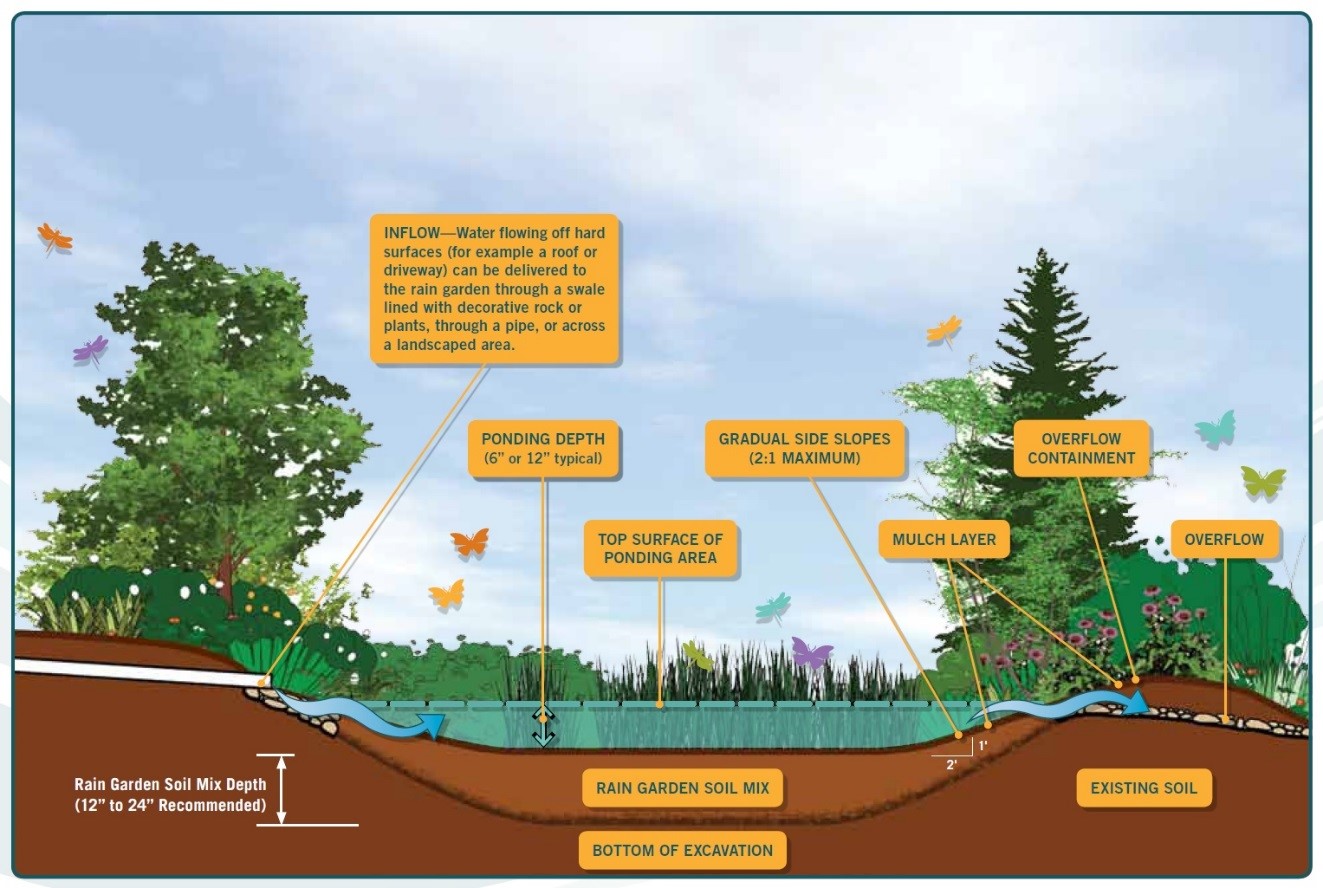
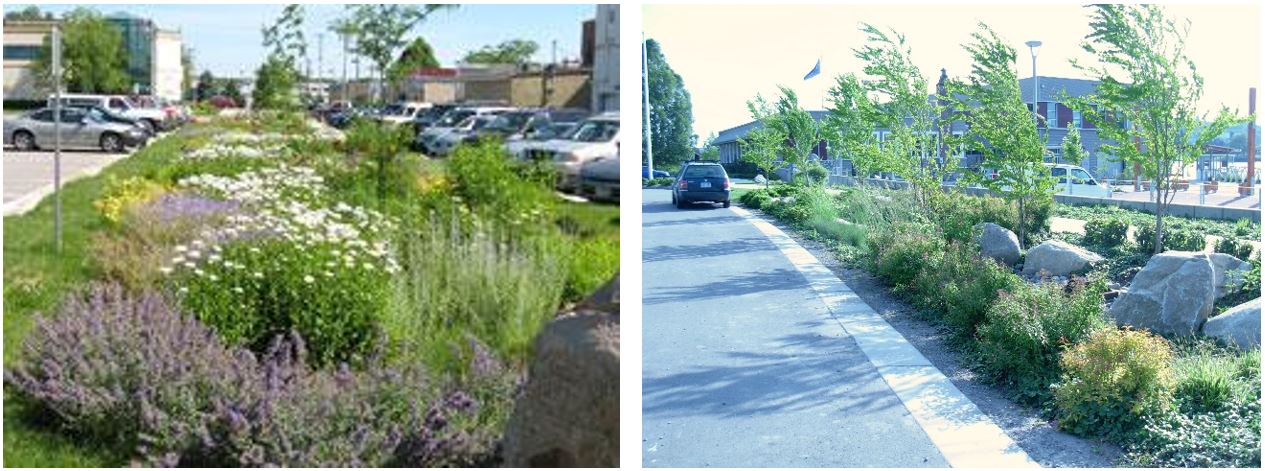
(Ord. 011-19 § 5 (Exh. 2)).
20.128.070 Landscape site design standards.
(1) Required Landscape Buffer Standards. Screening between certain uses may be called for in Table 20.128.070 below or elsewhere in this chapter:
(a) The provisions of this section do not apply to, and landscape buffers are not required for, development with a designated storefront block frontage (POMC 20.127.100 through 20.127.260) unless required as a condition of a permit (such as a conditional use permit or subdivision) or SEPA.
(b) Where mature trees and vegetation exist within the required buffer areas, the preservation of said mature trees and vegetation may be preferable to new plant materials. The director may require up to 50 percent additional buffer width and/or specific planting conditions to better ensure the survival of existing mature trees and/or augment existing plantings to meet the intent of the standards.
(c) The letters A, B, and C refer to the required landscape buffer type(s) (described in POMC 20.128.060). Where more than one buffer type is referenced at the intersection of the column and the row, only one of the listed buffer types is required.
(d) Where the cells at the intersection of the column and the row are empty, there are no landscaping buffer requirements for the particular situation.
(e) If a * appears after a use or term within the table, then the use or term is defined in Chapter 20.12 or 20.39 POMC.
(f) Where superscript numbers are included in a cell, see the corresponding note matching the number below the table.
(g) For the application of building additions, remodels and site improvements, the provisions of POMC 20.127.020(3) shall apply.
(h) Departures. Alternative buffer treatments may be approved per POMC 20.127.060 for any of the buffer types required below, provided they meet the purpose of this chapter.
|
Developing use |
Existing abutting uses and zones |
||||||||
|---|---|---|---|---|---|---|---|---|---|
|
Street, park or trail |
R1, R2, R6, GB zones |
R3, R4, R5 zones |
RMU, NMU, GMU, DMU, CMU, BPMU zones |
CC, CH zones |
IF zone |
IL zone |
IH zone |
CI, PF zones |
|
|
Single-family attached* (3 or more units) or multifamily* (3 or more units) |
See subsection (2) below. |
Fence plus BC-5' |
Fence plus BC-5' |
Fence and BC-5' and path |
Fence and BC-5' and path |
Fence plus AB-10' |
Fence plus AB-10' |
Fence plus AB-10' |
Fence plus BC-5' |
|
Low intensity nonresidential use* |
Fence plus ABC-5' |
Fence plus ABC-5' |
Fence or BC-5' or path |
Fence or BC-5' or path |
Fence plus ABC-10' |
Fence plus ABC-10' |
Fence plus ABC-10' |
Fence plus ABC-10' |
|
|
Moderate intensity nonresidential use* |
Fence plus ABC-10' |
Fence plus ABC-10' |
Fence or BC-5' or path |
Fence or BC-5' or path |
Fence plus ABC-10' |
Fence plus ABC-10' |
Fence plus ABC-10' |
Fence plus ABC-10' |
|
|
High intensity nonresidential use* |
Fence plus ABC-15' |
Fence plus ABC-15' |
Fence or BC-5' or path |
Fence or BC-5' or path |
Fence plus ABC-10' |
Fence plus ABC-10' |
Fence plus ABC-10' |
Fence plus ABC-15' |
|
|
Use featuring an open storage yard* |
Fence plus ABC-10' |
Fence plus ABC-10' |
Fence plus ABC-5' or A-10' |
Fence plus ABC-5' or A-10' |
Fence or A-5' or B-10' |
Fence or A-5' or B-10' |
Fence or A-5' or B-10' |
Fence plus ABC-10' |
|
|
Heavy industry* |
Fence plus ABC-20' |
Fence plus ABC-20' |
Fence plus ABC-5' or A-10' |
Fence plus ABC-5' or A-10' |
Fence plus ABC-5' or A-10' |
Fence plus ABC-5' or A-10' |
Fence plus ABC-5' or A-10' |
Fence plus ABC-20' |
|
(2) Street, Park, or Trail Buffers.
(a) For landscaping between uses or structures and streets, also see the applicable block frontage standards in POMC 20.127.100 through 20.127.260. Plant materials, installation, and maintenance are subject to the standards of this chapter.
(b) For nonresidential, single-family attached (three units or more), and multifamily development (three units or more), see POMC 20.127.220 for trail/park block frontage standards. Alternative designs will be considered based on the unique context of the site, the development, and the park/trail provided the designs promote safety for park/trail users, and mitigate any potential negative impacts of the proposed use on the park/trail.
(c) For storage yards, a minimum 10-foot wide planting strip with Type A landscaping is required between any street and such storage yard.
(3) Surface Parking Lot Landscaping.
(a) Parking Lot Perimeters.
(i) For parking lots abutting public right-of-way, use Type C landscaping at a width equal to or greater than the minimum building setback specified for the applicable block frontage type specified in POMC 20.127.100 through 20.127.260. For parking lots on sites without an applicable block frontage type, the parking lot landscape buffer shall be at least 10 feet deep.
(ii) For parking lots along internal private roadways in commercial areas, provide a planting strip at least six feet wide with Type C landscaping.
(iii) For parking lots along internal lot lines, use Type A or B landscaping at least 10 feet deep, except where a greater buffer width is required per the standards in Table 20.128.070.
Departures will be considered provided they meet the purpose of this chapter. Examples of acceptable departures may include decorative low walls with landscaping, decorative elevated planters, or landscaping with a trellis. In no case may landscaping buffers be less than five feet wide. The minimum height of planters or walls, where used, is three feet. The maximum height of walls where used shall be five feet.
Figure 20.128.070(3)(a)
Parking Lot Perimeter Landscaping Departure Examples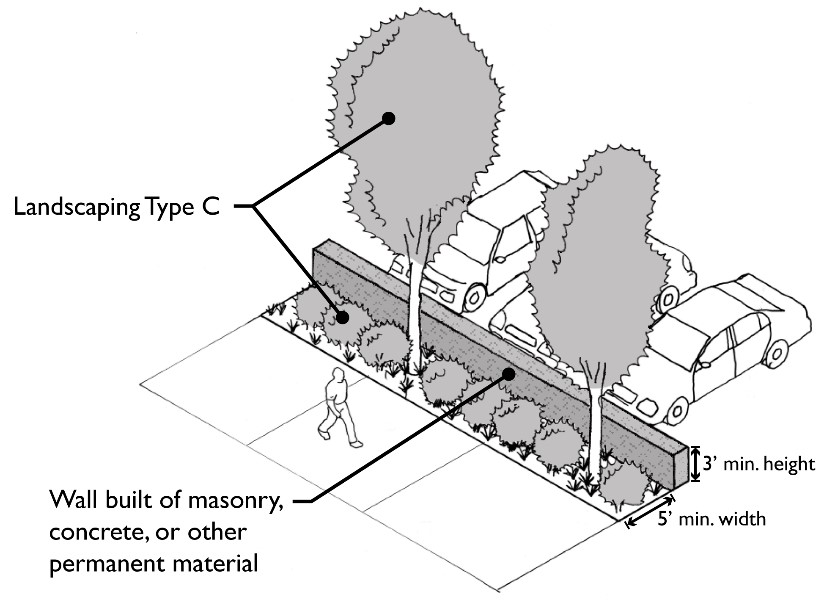
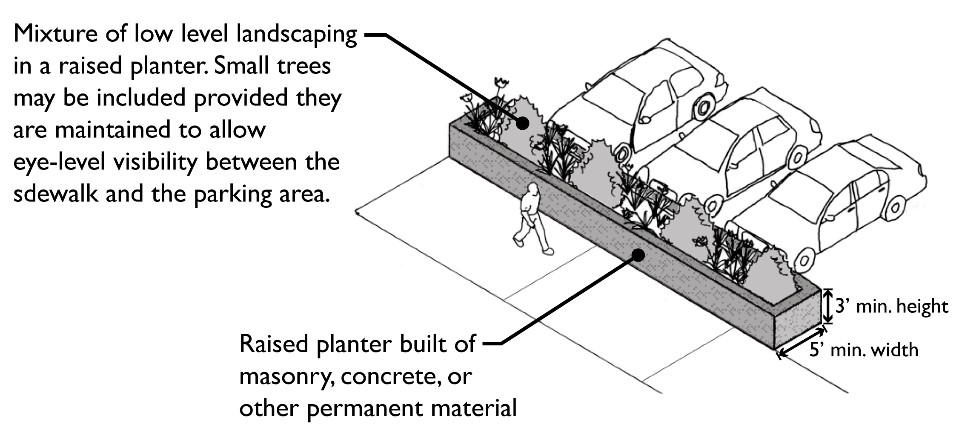
(b) Internal Parking Lot Landscaping.
(i) Trees and Shrubs Required.
(A) For every 1,000 square feet of vehicular use area, at least one deciduous tree must be planted.
(B) Trees and shrubs must be planted within 15 feet of the parking lot to count as parking lot landscaping.
(C) When a development contains 20 or more parking spaces, 50 percent of the trees and shrubs must be planted in islands or medians located within the parking lot.
(ii) Landscaping Type.
(A) Type C landscaping shall be utilized for landscaping islands internal to parking lots.
(B) At least 75 percent of the required deciduous trees must be large trees. Medium and small trees are acceptable where overhead electric lines would interfere with normal growth.
(C) Rain gardens and swales may be integrated into required planting areas.
(iii) Landscaped Island Sizes. At a minimum, tree islands shall be a minimum of 256 square feet. Planting islands must be at least six feet deep and wide.
(iv) Landscaped Island Spacing. Parking bays shall be broken up with landscaped islands or medians to avoid long monotonous rows of parking. Tree islands shall be evenly distributed throughout the parking lot in order to provide an even tree canopy throughout the lot.
(v) Each parking space must be located within 75 feet of a tree measured from the closest point of the parking space to the tree trunk.
Departures will be considered provided they meet the purpose of this chapter.
(4) Foundation Planting. All street-facing elevations must have landscaping along any exposed foundation. The landscaped area may be along the outer edge of a porch instead of the foundation. This landscaping requirement does not apply to portions of the building facade that provide access for pedestrians or vehicles to the building. The foundation landscaping must meet the following standards:
(a) The landscaped area must be at least three feet wide.
(b) There must be at least one three-gallon shrub for every three lineal feet of foundation.
(c) Ground cover plants must fully cover the remainder of the landscaped area.
Figure 20.128.070(4)
Foundation Planting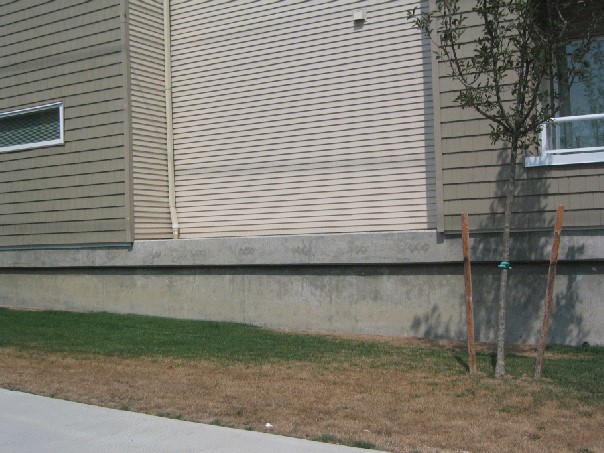
(5) Existing Vegetation.
(a) Existing healthy, native, and noninvasive vegetation may be used to fulfill the requirements of this chapter.
(b) When existing vegetation is proposed to be used to fulfill the requirements of this chapter, that vegetation shall be shown on required landscape plans as “existing vegetation to be retained” and prior to land disturbing activities, these areas shall be flagged in the field and be protected by construction fencing. In the event that existing vegetation proposed to be used to fulfill the requirements of this chapter is altered, damaged, or removed during development or construction activity, this area shall be restored to its original state after the development or construction activity is complete, or, shall be replanted in accordance with a new revised landscaping plan developed and approved in accordance with this chapter.
(6) Stormwater Facilities.
(a) Plant-based stormwater treatment facilities such as rain gardens (see POMC 20.128.060(6)) and swales may be used to meet the requirements of this section as provided elsewhere in this chapter.
(b) Stormwater detention facilities such as ponds and collection basins may not be used to meet the requirements of this section unless designed per subsection (6)(a) of this section. (Ord. 011-19 § 5 (Exh. 2)).
20.128.080 Development within required buffers.
This section applies to buffers that are required per Table 20.128.070.
(1) Pedestrian walkways are allowed within buffers, subject to the following standards:
(a) Walkways shall not exceed five feet in width.
(b) Walkways shall cross buffers at an angle between 60 and 90 degrees.
(c) Walkways may only run along the length of a buffer if the buffer is at least 40 feet in width, and the walkway is located within the inner 25 percent of the buffer.
(2) Utilities are not permitted in buffers within a residential subdivision, unless no reasonable alternative exists. However, utilities may be installed in an easement that is located along street frontage and parallel to the street. If utilities are placed in a buffer, they shall be located and installed in a way that minimizes disturbance of the buffer area: not parallel, but crossing at an angle between 60 and 90 degrees. If stormwater drainage channels are placed in a buffer at an angle less than 60 degrees, the buffer width shall be increased by the width of the utility easement or disturbance, or at least 10 feet, whichever is greater. (Ord. 011-19 § 5 (Exh. 2)).
20.128.090 Irrigation standards.
The purpose of this standard is to ensure that plants will survive the critical establishment period when they are most vulnerable.
All required landscaped areas in the city must comply with at least one of the following:
(1) A permanent built-in irrigation system with an automatic controller will serve the proposed landscape area, and the system will be installed and operational before the city grants an occupancy permit or final inspection for the development.
(2) A temporary irrigation system will serve the proposed landscape area, provided the applicant can successfully demonstrate that the proposed temporary irrigation system will provide sufficient water to ensure that the plant materials to be planted will survive installation and, once established, will survive without watering other than natural rainfall.
(3) A permanent or temporary irrigation system will not serve the proposed landscape area, provided:
(a) The director finds the landscape area otherwise fulfills the requirements of this section; and
(b) The applicant submits all of the following with the site plan application:
(i) A statement from a Washington State licensed landscape architect, Washington-certified professional horticulturalist (CPH), or other qualified individual certifying that the materials to be planted will survive without watering other than natural rainfall.
(ii) A plan for monitoring the survival of required vegetation on the approved site plan for at least one year and for detection and replacement of required vegetation that does not survive with like-kind material or other material approved by the director.
(iii) A statement from the applicant agreeing to install an irrigation system if the director finds one is needed to ensure survival of required vegetation, based on the results of the monitoring plan. (Ord. 011-19 § 5 (Exh. 2)).
20.128.100 Maintenance of required buffers and landscaped areas.
(1) Maintenance Responsibility. The owners of the property and their agents, heirs, or assigns shall be responsible for the installation, preservation, and maintenance of all planting and physical features (installed or vegetated natural areas) required under this chapter. Damage to these areas shall result in the revegetation requirements or fines per Chapters 2.64 and 20.02 POMC.
(2) Inspections after Second and Fifth Year. The director shall inspect the site two and five years after the issuance of a permanent certificate of occupancy in order to ensure compliance with the approved landscape plan and to ensure that the landscaping is properly maintained. Failure to maintain required landscape areas on a permanent basis may result in fines according to Chapters 2.64 and 20.02 POMC.
(3) Maintenance Responsibility, Replacement of Damaged Vegetation, and Associated Fines.
(a) The owners of the property and their agents, heirs, or assigns must be responsible for maintaining all required landscaping and screening areas in a healthy, growing condition.
(b) All landscaping and screening areas must be maintained reasonably free of weeds and trash, must be treated for pest/diseases in accordance with the approved landscape plan, and must be maintained so as to prevent mulch, straw, dirt, or other materials from washing onto streets, sidewalks, and adjoining properties.
(c) Limbing up trees and “topping” or shearing off trees is prohibited, unless required for public safety reasons approved by the director.
(d) The property owner shall take actions to protect trees and landscaping from unnecessary damage during all facility and site maintenance operations.
(e) Any dead, unhealthy, or missing vegetation, or vegetation disfigured by severe or excessive pruning, unusual weather occurrence or natural catastrophe, or other natural occurrence such as damage by wild or domestic animals, must be replaced with equivalent vegetation that conforms to the plant materials and installation standards in POMC 20.128.050, other applicable standards of this title, and the approved site plan.
(f) The owner shall have one growing season to replace or replant after receiving notice from the director. The director shall consider the type and location of the required vegetation area in making a determination on the extent of replanting requirements.
(g) Failure to maintain all plantings in accordance with this section shall constitute a violation of the Port Orchard Municipal Code and may result in fines in accordance with Chapter 20.02 POMC.
(4) Landscape Maintenance Plan. The paragraph and list below regarding a landscape maintenance/management plan shall be placed on the landscape plan prior to plan approval, along with any other notes applicable to site landscaping. This statement may be individualized based on the specific characteristics of each site and its landscaping plan requirements. The maintenance plan shall be prepared by a Washington State licensed landscape architect, Washington-certified professional horticulturalist (CPH), or other qualified individual.
The owners of the property and their agents, heirs, or assigns shall be responsible for the installation, preservation, and maintenance of all planting and physical features shown on this plan. The owners shall be responsible for maintenance of the vegetation, including but not limited to:
(a) Fertilization.
(b) Pruning.
(c) Pest control.
(d) Mulching.
(e) Mowing (if any).
(f) Protection of the root zones from equipment, construction and storage of materials.
(g) Watering.
(h) Other continuing maintenance operations.
Failure to maintain all plantings in accordance with this plan shall constitute a violation of the Port Orchard Municipal Code and may result in fines.
(Ord. 011-19 § 5 (Exh. 2)).
20.128.110 Performance assurance/bonding.
In the event that landscaping improvements cannot be installed prior to final plat, final short plat, final binding site plan or formal certificate of occupancy, a cash deposit, letter of credit or other assurance acceptable to the city equal to 150 percent of the estimated landscaping and installation costs must be required. Such deposit must be accompanied by a letter which stipulates completion of all landscape development no later than the next autumn planting season following issuance of the certificate of occupancy or date of final approval, whichever is later. If these conditions are not met, the city may use the deposit to install the landscaping. (Ord. 011-19 § 5 (Exh. 2)).
20.128.120 Maintenance assurance/bonding.
Prior to granting a (permanent) certificate of occupancy and/or granting final approval of site improvements, the owner of the subject property shall provide a two-year landscape maintenance bond, cash set-aside, or other assurance acceptable to the city (hereafter “assurance”) in an amount equal to 125 percent of the estimated landscaping and installation costs for the project. It shall be the owner’s responsibility to request a landscape maintenance inspection at least two years after city acceptance upon final landscaping installation inspection. The assurance shall not be released by the city unless the city finds upon inspection that the landscaping has been maintained and is in good health. If the city finds that the landscaping has not been maintained or is not in good health, the city may at its option require the owner to maintain and restore the required landscaping to healthy conditions prior to releasing the landscape maintenance assurance, or may itself perform work to correct the deficiencies using the provided assurance. In the event that a significant amount of the required landscaping requires replacement as determined by the director, the city may require an additional two-year landscape maintenance assurance on all or a portion of the required landscaping. (Ord. 011-19 § 5 (Exh. 2)).


